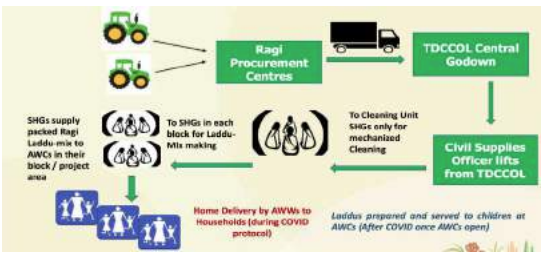Ragi Laddu in ICDS
Ragi Laddu in ICDS
Summary of the Initiative
The Odisha Government’s project, “Special program for promotion of millets in tribal areas” aims to revive millets in farms and on plates considering the climate resilience of the crops and its high nutritional value. Ragi or finger millets has better calcium, iron, and protein than polished rice, is grown enormously in the tribal districts of Odisha. With a little innovation and some value addition, it has turned out to be a benchmark in nutrition promotion by ICDS among pre-school children.
Situation before the Initiative
Data from NFHS-4 shows that Odisha ranks in the top 10 of the most affected States of under-five year child malnutrition on all the three indicators of wasting, stunting and underweight. In terms of deprivations and marginalization, the state also has some of the highest proportion of tribals in the country Odisha has a tribal population of roughly 22.5% with high malnutrition outcomes.
Nature of the Initiative
To test the nutritional sufficiency of millets, Odisha Millet Mission’s High-Power Committee decided to take up the consumption of “Ragi Laddus” on a pilot basis in 335 Anganwadis in the Sadar block of Keonjhar district of Odisha starting from July 2020. From September 2020 onwards, the pilot was replicated all over Keonjhar district as well as in the neighboring Sundargarh district. The District Mineral Fund (DMF) of the respective districts have been funding this initiative. DMF Keonjhar has reported investing nearly Rs. 1.5 crores per annum for this initiative. Ragi Laddu is given as a morning snack additionally to existing menu in Sundargarh and Keonjhar. CFTRI is working with the Odisha Government on recipes and other requests related to shelf life, nutritional profiling etc.
The objective of inclusion of millets in ICDS were:
- To increase food diversity
- Promote local consumption
- Provide additional nutrition

Recipe of Ragi Laddu
| Ingredients | Quantity (in gms) |
| Roasted Ragi flour | 11.00 |
| Roasted Sesame | 1.00 |
| Powdered Sugar | 5.00 |
| Powdered Ground nuts | 1.00 |
| Powdered Cardamom for flavour | 0.04 |
| Oil | 2.00 |
| Total | 20.04 |
| Cost of per Laddu | 1.90 Rs |
A Shelf life study of ragi laddu mix was done whose observations were that the laddu mix exhibited a shelf life of 168 days, after 154 days showed slightly stored flavor, at ambient conditions.
The COVID-19 lockdown and the closing of anganwadis did not deter this initiative. Instead of distributing packaged ragi laddus, the programme creatively home delivered a ragi laddu mix to efficiently distribute the sanctioned amount.
Initially provisioned for 2 laddus per week per child, the initiative’s strong acceptance by both the children and their parents combined with achieving the desired outcome in its pilot phase has led to an increase in the provisioning to 4 laddus per week per child. As of now, 21 Women SelfHelp Groups (WSHGs) and 39 WSHGs in Keonjhar and Sundargarh districts respectively are engaged in preparing the Ragi Laddu Mix.
Impact of Initiative
Odisha has become the first State to introduce “Ragi Laddus” as a morning snack in ICDS. 3,257 and 3,809 Anganwadi centres in Keonjhar and Sundargarh districts respectively have been catering to nearly 1.5 lakh pre-school children through this initiative since September 2020 with the help of DMF. Total reach of the initiative is presented in Table.
Reach of the Initiative
| Sundargarh | Keonjhar | Total | |
| No of Children Covered | 60,000 | 80,000 | 1.4 lakhs |
| No of AWCs Covered | 3809 | 3257 | 7066 |
| No of SHGs engaged in supply of Laddu Mix | 39 | 21 | 60 |
One of the reasons for the success of this initiative was that it was participatory. Recipes were finalized in consultation with mother committees, teachers, cooks and children for acceptance. A Community Acceptance Feedback Survey in Hemgir Block Sundargarh during Phase-1 was undertaken by Nabakrushna Choudhury Centre for Development Studies. The results of the survey are given below:

Campaigns were undertaken to generate awareness in the community. Posters were designed for children in Sundargarh and Keonjhar to create awareness and interest amongst children regarding ragi consumption. Instruction Manual is provided to households on “How to use Ragi Laddu Mix”
Acknowledging the success of the program, the State has decided for an expansion of Ragi Laddu as a snack in ICDS in all Districts. Odisha is also considering to conduct a Pilot of Ragi Based THR as well as pilot of Little Millet Khichri as hot cooked meal in ICDS.
Source : Promoting Millets in Diets - Best Practices across States/UTs of India - A NITI Aayog publication
Last Modified : 5/3/2024
Provides overview of farm machinery available for...
This topic provides information about Hybrids and ...
This topic provides information about Comprehensiv...
This topic highlights the importance of nutrient r...
